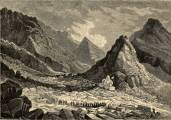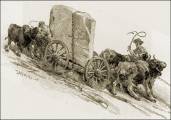


The Kentucky Stone and Building Industry in 1882
Excerpts from
Mineral Resources of the United States, 1882
J. S. Powell, Director, Department of the Interior,
United States Geological Survey, Government Printing Office,
Washington, D. C., 1883.
Excerpts from the chapters on 1) "Structural Materials," and 2) "The Useful Minerals of the United States:
"The division of the Tenth Census charged with the collection of statistics of building stone obtained returns from 1,525 quarries in the United States, having an invested capital of $25,414,497, and producing during the year ending May 31, 1880, 115,380,133 cubic feet of stone, valued at $18,365,055. In value of total product, the leading States rank as follows: Ohio, Pennsylvania, Vermont, Massachusetts, Illinois, New York, Maine, and Connecticut; each of these States producing upwards of $1,000,000 worth of stone. Vermont, Illinois, Ohio, Iowa, Indiana, New York, and Missouri, in the order named, produce the most marble and limestone; Ohio, New York, Connecticut, and Pennsylvania, the greater part of the sandstone; Massachusetts and Maine quarry the most granite and other siliceous crystalline rocks; while Pennsylvania leads in product of slate."
Marble:
Lower Silurian formation, excellent building material, found along Kentucky river-a buff and cream-colored marble con- convenient (sic) to transportation; dolomites of sub-Carboniferous formation; oölitic limestone is extensively quarried at Bowling green, Warren county; near Clay's Ferry, on Kentucky river, Fayette county; Cane ridge, east of Paris, Bourbon county; Glasgow junction, Barren county; Hopson's quarry, Coon creek; on Ohio river, Trimble county; in Nelson and Bullitt counties in Niagara group, dolomites of excellent quality and in vast quantities quarried to some degree; the Birdseye and Chazy groups on the Kentucky and (blank space) rivers contain fine durable stones.
KENTUCKY
Reported by John C. Smock.
Ores, minerals, and mineral substances of industrial importance, which are at present mined.
Lithographic stone: Glasgow junction, Barren county, and Estill county, localities in Wayne, Pulaski, Warren, and Rockcastle counties.
Marble: Lower Silurian formation, excellent building material, found along Kentucky river-a buff and cream-colored marble con- convenient (sic) to transportation; dolomites of sub-Carboniferous formation; oölitic limestone is extensively quarried at Bowling green, Warren county; near Clay's Ferry, on Kentucky river, Fayette county; Cane ridge, east of Paris, Bourbon county; Glasgow junction, Barren county; Hopson's quarry, Coon creek; on Ohio river, Trimble county; in Nelson and Bullitt counties in Niagara group, dolomites of excellent quality and in vast quantities quarried to some degree; the Birdseye and Chazy groups on the Kentucky and (blank space) rivers contain fine durable stones.
Sandstone - Freestone: Cumberland sandstone in basin of Cumberland river, a greenish colored stone. Waverly period; Sandstones of this period have been extensively quarried; worked along the Ohio river and southeast of Mount Sterling, in Montgomery county; occurs along Licking, Kentucky Salt, and green rivers, also commonly known as "Buena Vista stone;" used largely in Cincinnati, Louisville, and other western cities; Bullitt's lick and Belmont furnace, Bullitt county; Triplett's creek, mouth, edge of Rowan county, knob building stone.
Commercial use of material within this site is strictly prohibited. It is not to be captured, reworked, and placed inside another web site ©. All rights reserved. Peggy B. and George (Pat) Perazzo.